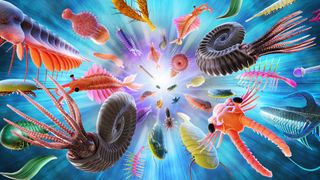Did the Cambrian explosion really happen?
Something unique does seem to have taken place during this time when so many animal groups first appeared, but it's not an open-and-shut case.

A cursory flip through any high school biology textbook will inevitably surface a mention of the Cambrian explosion, a period about 540 million to 520 million years ago during which many animal groups first sprang into life and diversified. The event is frequently described as rapid and prolific, evoking a chaotic moment in early evolutionary history.
But was there really a dramatic burst of biodiversity on Earth during this time?
Thomas Servais, a paleontologist and research director at the French National Center for Scientific Research (CNRS), and colleagues published a 2023 paper in Palaeogeography, Palaeoclimatology, Palaeoecology arguing that the Cambrian explosion didn't happen in the way it's popularly portrayed. It wasn't truly an explosion, he told Live Science, but rather a gradual increase in biodiversity that took place throughout the early Paleozoic era (541 million to 251.9 million years ago). The appearance of an "explosion," he said, is really an artifact of the biases scientists have when studying the past.
The process of locating, excavating and cataloging fossils is costly and laborious, so researchers often add their specimens to large databases to make it easier to compare finds. Two of these databases, the Paleobiology database and the Geobiodiversity database, collectively contain roughly 2 million entries and have been used to investigate global patterns in biodiversity, including trends that appear during the Cambrian.
The authors assert that these resources aren't truly global, however. The Paleobiology database is largely made up of fossils found in Europe and North America, while the Geobiodiversity database mostly includes fossils from China. These regions host some of the most famous Cambrian deposits in the world — including Canada's Burgess Shale and the Chengjiang fossil bed in China's Yunnan province — that pull the majority of the funding. But at best, they can give "a regional assessment of patterns in diversity, and then only for those species that preserve well enough to persist in the fossil record," Servais said.
The databases also include specimens from another period, called the Great Ordovician biodiversification event (GOBE), thought to have taken place roughly 40 million to 50 million years after the Cambrian explosion. The period between the two events is relatively understudied and seems to lack the same pattern of flourishing biodiversity. But this too, Servais said, is the result of bias on the part of scientists. Were they to put the same effort into studying this period, the existence of two individual events would likely melt away, he said.
Related: Why do Cambrian creatures look so weird?Researchers have unearthed numerous fossils from the Cambrian period. (Image credit: NPS)
Karma Nanglu, a paleontologist at Harvard University who studies Cambrian and Ordovician fossils, told Live Science he understands why Servais and his colleagues would like to tamp down on the use of terms like "explosion" and "event," and said it's well-accepted in the field that biodiversity estimates may be influenced by sampling bias. "But to my mind, I still do think there is actually quite good evidence that there was a Cambrian explosion, as we would typically call it," he said.
Regardless of whether the databases are biased toward certain groups or areas, there is a general trend of increasing complexity that is visible in the animals themselves.
"It's not just that two species are equivalent to each other in terms of what they contribute to diversity, it's that species A and species B are drastically different from each other in terms of the way their bodies are organized, how they develop, what their ecological role might be, how they live," Nanglu said. "And to that point, I think there's direct evidence that you can read straight from the rocks.
The causes for this biodiversification aren't fully known, but scientists have a few ideas. During the Precambrian, the supercontinent Rodinia broke apart into pieces, including Gondwana (modern-day Antarctica, South America, Africa, Australia, India and New Zealand) and Laurentia (most of North America). During this time, oxygen levels in the ocean increased, and there was a greater proportion of warm, shallow, tropical coastline — the perfect conditions for new species to evolve and later be fossilized in. A similar hypothesis has been studied for the breakups of the supercontinents Pannotia and Pangaea much later, and researchers have identified a link between the fracturing and animal diversity in the Phanerozoic eon (541 million years ago to the present).
No comments:
Post a Comment